3 Questions: Hessam AzariJafari on mitigating climate change with reflective pavements

Extreme heat events — like those seen in California in 2020 — are expected to worsen over the century due to climate change and urban heat islands (UHIs). Cities will likely experience the brunt of those effects.
To help cities mitigate UHI and extreme heat, MIT Concrete Sustainability Hub postdoc Hessam AzariJafari is studying one of the most abundant urban surfaces: pavements. He has found that it’s possible to significantly lower urban air temperatures and greenhouse gas emissions by altering pavement surface reflectivity. However, as he explains below, the effects of reflective pavements can depend heavily on where they are implemented.
Q: What are reflective pavements and how do they impact climate change?
A: Reflective pavements are a paving strategy that can help solve the problem of urban heat islands. The so-called “cool pavement” strategy is currently practiced in a few cities, such as Los Angeles, by implementing reflective coatings and/or brighter-color materials in the pavement mixtures. These properties allow more sunlight to be reflected from a pavement’s surface, and less to be absorbed by its mass. As a result, reflective pavements can lower urban temperatures when the ambient temperature is lower than the pavement surface temperature. In Los Angeles, for instance, we found that reflective pavements would reduce the occurrence of heat waves by around 40 percent over 20 years.
In addition to altering air temperatures, pavements also influence climate change. By reflecting light into building envelopes, they can alter heating and cooling demands and their associated greenhouse gas (GHG) emissions in the surrounding neighborhoods. Moreover, by sending a larger amount of solar irradiation to the sky, they can alter the Earth’s energy balance. This process, known as a radiative forcing, creates a cooling effect that can help counteract climate change.
Q: How do the effects of reflective pavements vary by context?
A: The effectiveness of reflective pavement strategies in reducing climate change impact depends on several factors. One major factor is geographical context. The local climate condition, including real-time temperature, cloud factors, and relative humidity, plays an important role in the intensity of radiative forcing, as well as changes to building energy demand (BED) due to heating and cooling.
Within urban areas, the neighborhood morphology, such as building density and canyon aspect ratio [ratio of building heights to the adjacent pavement width], can considerably change the BED effect of reflective pavements. Building configuration characteristics, such as the ratio of the surface area to volume, the insulation system, and the heating and cooling technology also affect the intensity of BED change.
The efficiency and sustainability of the local grid play a part as well. For example, generating one kilowatt-hour of electricity in Phoenix emits 85 percent more greenhouse gas emissions than in Boston. That’s because a small proportion of the electricity generation is from low-GHG sources in Arizona. Therefore, increases in building energy demand in Phoenix can have a larger climate change impact.
Q: Many aspects of a pavement contribute to its life-cycle environmental footprint. Where does surface reflectivity fit into that total footprint?
A: Surface reflectivity is just one part of a pavement’s cumulative life-cycle emissions. Additional impacts include pavement construction and repairs, the extra fuel consumption of vehicles induced by pavement properties, and the end-of-life landfilling or recycling.
Just as with pavement reflectivity, these impacts can also vary by context. For example, in urban neighborhoods, the BED effect of pavements is more pronounced because there are hundreds of thousands of apartment units located in the city whose energy demands will be altered by the surface reflectivity of pavements. Since pavements in those dense urban areas also service a relatively low volume of traffic, the contribution of their reflectivity to their total life-cycle impact is more significant as well. However, on highways, which see significantly greater levels of traffic, the surface roughness and structural properties of a pavement contribute to a greater proportion of that pavement’s life-cycle emissions by influencing the fuel consumption of vehicles. Therefore, it is important to consider all elements of a life cycle when municipalities and transportation authorities decide on the environmentally preferred option.
The research was supported through the MIT Concrete Sustainability Hub by the Portland Cement Association and the Ready Mixed Concrete Research and Education Foundation.


